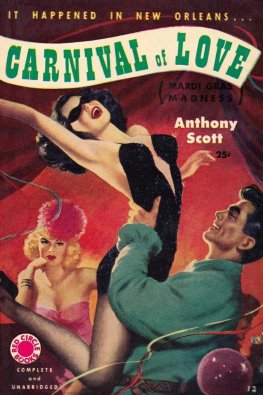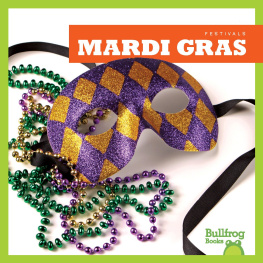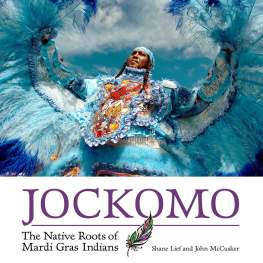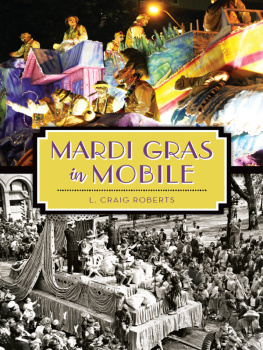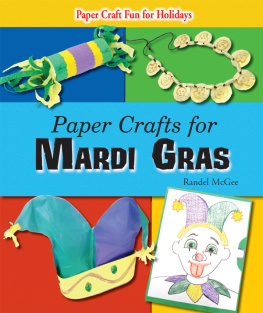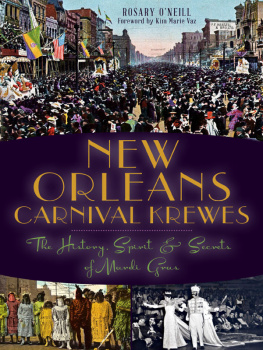
CARNIVAL
IN LOUISIANA

Leopard masker on New Orleans Canal Street welcomes all the world to Carnival in Louisiana.
(Louisiana Office of Tourism)

CARNIVAL
IN LOUISIANA

Celebrating Mardi Gras
from the French Quarter to the Red River
BRIAN J. COSTELLO

LOUISIANA STATE UNIVERSITY PRESS
BATON ROUGE
Published by Louisiana State University Press
Copyright 2017 by Louisiana State University Press
All rights reserved
Manufactured in the United States of America
First printing
Designer: Michelle A. Neustrom
Typefaces: Adobe Garamond Pro, text; Tribute, display
Printer and binder: McNaughton & Gunn, Inc.
Library of Congress Cataloging-in-Publication Data
Names: Costello, Brian J., author.
Title: Carnival in Louisiana : celebrating Mardi Gras from the French Quarter to the Red River / Brian J. Costello.
Description: Baton Rouge : Louisiana State University Press, [2017] | Includes bibliographical references.
Identifiers: LCCN 2016041284| ISBN 978-0-8071-6652-9 (cloth : alk. paper) | ISBN 978-0-8071-6653-6 (pdf) | ISBN 978-0-8071-6654-3 (epub) | ISBN 978-0-8071-6655-0 (mobi)
Subjects: LCSH: CarnivalLouisiana. | LouisianaSocial life and customs.
Classification: LCC GT4210.L8 C66 2017 | DDC 394.2509763dc23
LC record available at https://lccn.loc.gov/2016041284
The paper in this book meets the guidelines for permanence and durability of the Committee on Production Guidelines for Book Longevity of the Council on Library Resources. 

To all those who have made Carnival in Louisiana possible each year: those untold individuals and groups behind the scenes and behind the masks who have provided the inspiration, time, talent, and financial resources for the perpetuation and promotion of the states signature celebration. Merci beaucoup.

Spanish Town parade-goers vie for throws cast from floats in Baton Rouges longest parade.
(Courtesy Amanda M. Scallan)
CONTENTS
1. The Old-Line
Four: Comus, Rex, Momus, and Proteus
PREFACE
T he aim of Carnival in Louisiana is to provide a historical summary of, comparison between, and thorough-as-possible listing of the various Carnival festivities currently held in Louisiana. The large number of events in the state makes it difficult, if not impossible, to give due attention to every parade, ball, and other celebration. For well-documented parades and balls dating back a century or more, the task is relatively easy. Including events that are only a year or two old, or more spontaneous and low-key in organization, requires more research. Regardless, for the benefit of would-be revelers, readers should come to appreciate the diversity of present-day Carnival festivities in Louisiana and their history.
The book is organized by geographic/cultural region to survey the areawide festivities that a particular destination offers. New Orleans, the Carnival City, and its suburbs remain unparalleled in the age, scope, distinction, and variety of their pre-Lenten events. Southwest Louisiana encompasses the cities of Lafayette, Lake Charles, Houma, and Thibodaux, whose street parades are more or less similar to those of New Orleans. Smaller communities of Acadiana host the incomparably colorful rural Courir de Mardi Gras.
Southeast Louisiana includes the old Creole French town of New Roads; the relatively new-to-parading capital city of Baton Rouge; the Florida Parishes cities of Hammond, Mandeville, Covington, Slidell, and more; and the towns in the River Parishes bordering the Mississippi between Baton Rouge and New Orleans. The parades of Central and North Louisianaspecifically the Alexandria, Monroe, and Shreveport regionswhile younger in age than most of the southern festivities, are growing in number and popularity and resemble the New Orleans pattern but with less emphasis on the secrecy of old-line Carnival.
This volume relies principally on the authors thirty-odd years of personal research in archival and contemporary print-news sources and, to a lesser extent, krewe histories. Both of these types of resources have consistently elaborated on the details of the festivities, including each years parade themes, number of floats and bands, crowd estimates, weather conditions, and parade incidents. Direct quotes are referenced by endnotes; general information, by abbreviated sources at the end of each part division. Full sources are listed in the bibliography.
T he author extends sincere gratitude to LSU Press acquisitions editor Margaret H. Lovecraft, with whom researching, crafting, and illustrating a book of this scope was a joy as well as a privilege and a learning experience. She joined me, my wife, Mary, and my family in field research in the form of attending Mardi Gras parades and related indoor festivities, which proved to be as fun as they were informative.
Special thanks are offered to the photographers and agencies who loaned their images to help illustrate the text: Country Lane Photography, Margaret H. Lovecraft, Amanda M. Scallan, Laura R. Gleason, Brandon M. Dufrene, Will Avera, Mary J. Langlois, Matthew Noel for the Houma Area Convention and Visitors Bureau, Amy Lynn Treme and Jim Noetzel for the Shreveport Convention and Tourist Bureau, the Krewe of Janus, the Pointe Coupee Banner, Slidell Mardi Gras Museum, Iberville Parish Library, Alexandria-Pineville Convention and Visitors Bureau, the State Library of Louisiana, and the Louisiana Office of Tourism. Gratitude is also extended to those patient individuals who assisted in the considerable task of locating, selecting, and receiving permissions for the photos: Arriollia Bonnie Vanney, Charlene Bonnette, Norris Fontenot, Mary Catherine R. LaCour, Barbara M. Hebert, Erin L. Rolfs, Jeff Richard, Chris Jay, Joey Pierce, and Tamie Fingleton.
Finally, to my wife, Mary, bien merci for supporting my varied Carnival commitments through the years and this newest manifestation of my lifelong love of and dedication to the preservation and promotion of Louisianas Carnival traditions.

CARNIVAL
IN LOUISIANA

Introduction
Ancient Origins, Louisiana Adaptations
T he state of Louisiana, known the world over for its history, folklore, and
Next page

